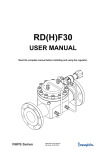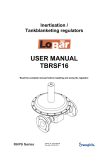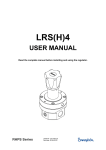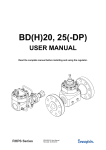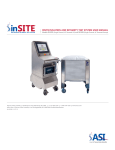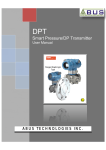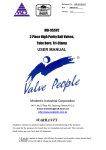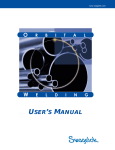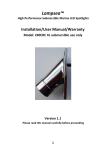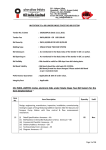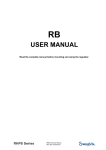Download USER MANUAL
Transcript
LBSN4 USER MANUAL Read the complete manual before installing and using the regulator. LBSN4 User Manual Rev.date: 20-09-2010 WARNING INCORRECT OR IMPROPER USE OF THIS PRODUCT CAN CAUSE SERIOUS PERSONAL INJURY AND PROPERTY DAMAGE. Due to the variety of operating conditions and applications for this product, the user is solely responsible for making the final proper decisions concerning the correct assembly and functioning of the product and assuring that all the performance, safety and warning requirements are met. • Users must be trained and equipped for the handling, use and servicing of pressure products and systems. • Users must contact their gas or liquid supplier for specific safety precautions and instructions. • Gaseous media should be free of excessive moisture to prevent icing at high flow. • Always wear the appropriate protective clothing, including safety glasses, gloves etc. if required. • Follow the applicable safety and maintenance procedures. • Obey specific local regulations. • Do not exceed the maximum inlet and outlet pressure of the product or its accessories. • Operate within the temperature limits and other conditions specified for the product. • Do not drop or damage the product in any other way. This may negatively effect the performance of the product which can cause the product to malfunction. • Venting fluids and gases can be dangerous. Vent to a safe environment away from people. Ensure adequate ventilation. • This product is not oxygen clean and therefore not suitable for oxygen service. If there are questions or problems regarding the installation, operation and maintenance these should be directed to the proper authority on site before continuing. LBSN4 User Manual Rev.date: 20-09-2010 CONTENTS 1 Introduction ..................................................................................................................................... 1 1.1 Detailed description ....................................................................................................................... 1 1.2 Special features and options ......................................................................................................... 1 1.3 Typical picture of the standard LBSN4 and its components ......................................................... 2 2 Installation ....................................................................................................................................... 3 2.1 Points of attention before installation ............................................................................................ 3 2.2 Oxygen service ............................................................................................................................. 3 2.3 Installation instructions .................................................................................................................. 4 3 Operation ......................................................................................................................................... 5 3.1 Required tools for operation .......................................................................................................... 5 3.2 Points of attention before operation .............................................................................................. 5 3.3 Changing the set pressure ............................................................................................................ 6 4 5 Maintenance..................................................................................................................................... 7 4.1 Required tools for maintenance. ................................................................................................... 7 4.2 Points of attention before removal from the system and disassembly.......................................... 8 4.3 Removal from the system ............................................................................................................. 8 4.4 Disassembly .................................................................................................................................. 8 4.5 Inspection of disassembled parts .................................................................................................. 8 4.6 Points of attention before assembly .............................................................................................. 8 4.7 Assembly ....................................................................................................................................... 8 4.8 Recommended torques ................................................................................................................. 9 4.9 Testing........................................................................................................................................... 9 4.9.1 Leakage across the seat ........................................................................................................... 9 4.9.2 Leakage across the diaphragm ................................................................................................. 9 4.9.3 Required outlet pressure range................................................................................................. 9 Trouble shooting ........................................................................................................................... 11 LBSN4 User Manual Rev.date: 20-09-2010 1 1 Introduction 1.1 Detailed description The function of a backpressure regulator is to maintain a constant inlet pressure and to control the inlet pressure with a variable flow. This regulator is a diaphragm sensing spring loaded backpressure regulator, designed for medium inlet pressure. It is ideal for highly accurate control of pressure because of it’s large effective sensing area. Combined with the “low torque-no wear” stem, the regulator is ideal for use in frequent readjustment type applications. The regulator comprises a body and spring housing bolted together and has a removable seat and valve. The product is designed to be used between -20 °C and +80 °C, whether ambient temperature or media temperature. The regulator is soft seated for leak tight shut-off in zero flow conditions and is available in stainless steel. The maximum in- and outlet pressure for the models are, limits for other connection types not included: - Threaded models LBSN4 : Inlet 35 bar Outlet 35 bar Check the assembly drawing or regulator for the specific pressure limits of the supplied regulator. Standard features: ss 316L throughout diaphragm sensing bubble tight shut-off 8mm valve 3 outlet ranges bottom mounting 1.2 Special features and options The regulator is available with the following options: panel mounting ss 316L diaphragm LBSN4 User Manual Rev.date: 20-09-2010 2 1.3 Typical picture of the standard LBSN4 and its components 1 2 4 9 10 11 15 16 17 19 body spring housing valve assembly seat o-ring seat retainer diaphragm clamp ring bottom spring guide set spring 20 22 23 24 25 26 LBSN4 User Manual Rev.date: 20-09-2010 spring guide spring housing cover knob assembly retaining ring socket head cap screw ring 3 2 Installation WARNING A BACKPRESSURE REGULATOR IS NOT A SAFETY VALVE AND SHOULD NOT BE USED AS SUCH. 2.1 Points of attention before installation This regulator can be equipped with different options and connections. Before installing the regulator you should fully understand the options and the suitability of your particular regulator and its suitability for the application. - - The preferred mounting position of the regulator is horizontal with the adjustment knob facing upwards. It may be necessary to remove the regulator from the system during maintenance or service. Make sure that this is possible, especially if mounted in a different position. The regulator is suitable for gases and liquids. Check if the materials on the assembly drawing, which came with the regulator, are compatible with the used media. If this regulator is used with hazardous or toxic media, take the necessary safety precautions to ensure a safe workspace and your personal safety. Vent to a safe environment away from people and ensure adequate ventilation. Avoid sealing compounds which harden, be careful with anaerobic (loctite type) compounds. Particles of these compounds can run into the regulator and lock moving parts. Frequent assembly and disassembly of the in- and outlet fittings can damage the in- and outlet thread of the regulator. Damaged threads can cause serious injury. The product is designed to be used between -20 °C and +80 °C, whether ambient temperature or media temperature. In all other cases consult SWAGELOK B.V.. The regulator is standard not oxygen clean. Although all regulators are ultrasonically cleaned, this does not make them suitable for oxygen use. 2.2 Oxygen service - Specification of materials in regulators for oxygen service is the user’s responsibility. SWAGELOK B.V. can perform cleaning for Oxygen service based on ASTM-G93LevelC/CGA4.1 at additional cost. LBSN4 User Manual Rev.date: 20-09-2010 4 2.3 Installation instructions - Verify that the regulator, the connections and its accessories are undamaged. Verify that the regulator and its accessories are suitable for the system operating pressure and have the proper connections. Carefully clean all pipes and connections. Any swarf, lint, wire etc. may cause seat leakage. Verify the flow direction of the system and mount the regulator accordingly. The standard connection of the LBSN4 is ½" NPT female. To get a proper sealing across the thread, SWAGELOK B.V. recommends using teflon tape. Securely make the appropriate connections to the regulator in accordance with the procedures recommended by the manufacturer of the connections. Verify that the regulator is mounted in the system without stress on the connections. Stress on the connections can result in faulty connections and dangerous situations. Check if the in- and outlet fittings are fitted far enough into the regulator and check for leakage across the fitting. Shut-off valves should be mounted in the system for service or maintenance. At the time of delivery, every unused gauge connection is plugged with blind fittings. Remove these and connect gauges if desired. If earthing is required, connect an earth wire under a spring housing bolt or in a bottom-mounting hole. - LBSN4 User Manual Rev.date: 20-09-2010 5 3 Operation 3.1 Required tools for operation For changing the set pressure on a standard regulator, no tools are required. 3.2 Points of attention before operation - The adjustment knob is provided with an anti-turnout locking ring, don't force it. The product can be hot or cold, depending on the environment temperature and the used media temperature. Take the necessary precautions before operating or touching the product. If this regulator is used with hazardous or toxic media, take the necessary safety precautions to ensure a safe workspace and your personal safety. Vent to a safe environment away from people and ensure adequate ventilation. After flow, the inlet pressure will fall a little under the set pressure. This is because of the closing force required for bubble-tight closing of the regulator. This phenomenon is usually referred to as the “reseat pressure” and does not indicate a problem with the regulator. An increase in the flow will result in a rise of the set pressure. A decrease in the flow will result in a fall of the set pressure. This is because of the force required for opening the valve of the regulator. This phenomenon is usually referred to as the “accumulation pressure” and does not indicate a problem with the regulator. An increase of the outlet pressure will result in a fall of the set pressure. A decrease of the outlet pressure will result in a rise of the set pressure. This phenomenon is usually referred to as the “dependency” and does not indicate a problem with the regulator. - - - - Each regulator type has its own dependency, which is related to the ratio between the effective seat area and the sensing area. The approximate change can be calculated as shown below: ΔP1 = ratio x ΔP2 A ratio of 1/X means that for every pressure change to P2 of X bar, the P1 pressure will change 1 bar: LBSN4, 0-3 bar: LBSN4, 0-9 bar: LBSN4, 0-20 bar: ratio = 1/52 ratio = 1/52 ratio = 1/27 Example: Regulator with ratio 1/27 Start position: P1 = 20 bar P2 = 0 bar End position P1 = ?? bar P2 = 19 bar ΔP1 = ratio x ΔP2 ΔP1 = 1/27 x (19-0) ΔP1 = 0,7 bar So, as a result of a pressure rise in the outlet pressure from 0 to 19 bar, the set pressure will fall from 20 bar to approximately 19,3 bar without adjusting the regulator. LBSN4 User Manual Rev.date: 20-09-2010 6 3.3 Changing the set pressure - Check the supply of medium at the inlet side. Make sure the inlet pressure is higher than the required set pressure and that the inlet pressure does not exceed the maximum allowed inlet pressure. Open the shut-off valve at the outlet side. Open the shut-off valve at the inlet side slightly to allow a minimal flow. Turn the adjustment knob clockwise to increase the set pressure. Turn the adjustment knob counterclockwise to decrease the set pressure. - A shut-off valve on the outlet side must be opened to relief the pressure on the outlet side. Final adjustment must be made while increasing the set pressure to obtain the most accurate set point(s). Reduce the inlet pressure until there is no more flow. Open the shut-off valve at the inlet side fully to allow full flow during operation. LBSN4 User Manual Rev.date: 20-09-2010 7 4 Maintenance WARNING INCORRECT OR IMPROPER REPAIR OR SERVICING OF THIS PRODUCT CAN CAUSE SERIOUS PERSONAL INJURY AND PROPERTY DAMAGE. SWAGELOK B.V. recommends the product to be removed from the system and to be shipped to SWAGELOK B.V. for service or maintenance as all regulators must pass rigid acceptance tests before leaving the factory. All repairs and servicing of this product must be performed by factory certified personnel and tested for operation and leakage. If this procedure is not followed for any reason, or if any customer changes are made to the product, SWAGELOK B.V. cannot assume responsibility for the performance or safety of a customer repaired product or for any damage resulting from failure of the product. The product should be checked periodically for proper and safe operation. It is the users sole responsibility to determine the frequency of maintenance based on the application. L RECOMMENDATION SWAGELOK B.V. RECOMMENDS TO HAVE SPARE-PART KITS READILY AVAILABLE ON SITE. All regulators require maintenance at scheduled intervals. Annual maintenance is recommended under normal use. From experience SWAGELOK B.V. can tell that especially during the start-up of a system, the demand for spare-part kits is high. This is despite all the effort taken to assure a clean system, there is usually some debris left in the system, which damages the regulator. Having spare-part kits on site will save time and money, as the downtime of the system will be reduced to a minimum, whether during start-up or normal operation. 4.1 Required tools for maintenance. - a vice to fasten the regulator pincers to take out the o-rings a pair of tongs for a retaining ring 8mm a torque wrench a torque wrench hexagon head key 5 an open end wrench, 13mm a “seat retainer” removing tool. (OT-1478-02) media and temperature compatible lubricant for reassembling threaded parts media and temperature compatible lubricant for o-rings soapy water for leak-testing LBSN4 User Manual Rev.date: 20-09-2010 8 4.2 Points of attention before removal from the system and disassembly - SWAGELOK B.V. recommends removing the regulator from the installation. Make sure that a spare-part kit is present. The adjustment knob is provided with an anti-turnout locking ring, don't force it. Check if the used media is hazardous or toxic. If required take the necessary safety precautions to ensure a safe workspace and your personal safety. Vent to a safe environment away from people and ensure adequate ventilation. Follow your system safety, maintenance or special local procedures when removing the regulator. The product can be hot or cold, depending on the environment temperature and the used media temperature. Take the necessary precautions before operating or touching the product. - 4.3 Removal from the system - Isolate the regulator from all pressure sources by closing the appropriate valves in the system. Turn the adjustment knob counterclockwise to decrease the set pressure. Make sure that the inlet and outlet pressure are both reduced to zero and that the adjustment knob is turned counterclockwise until it blocks, so that there is no more pressure in the regulator and no more spring force on the spring housing. A shut-off valve on the outlet side must be opened to relief the pressure on the outlet side. 4.4 Disassembly - Loosen the hexagon socket head screws and remove the spring housing, spring, bottom spring guide and valve assembly. Loosen the seat retainer to remove the seat and seat o-ring. 4.5 Inspection of disassembled parts - Check all parts for abnormal wear. Replace all parts in case of doubt. 4.6 Points of attention before assembly - All parts must be clean and undamaged before starting assembly. SWAGELOK B.V. recommends replacing all o-rings and the diaphragm before assembly. All threaded parts must be lubricated a little before assembly, this to avoid galling of threads. All o-rings need to be lubricated a little to improve the lifetime of the o-ring and the performance of the regulator. 4.7 Assembly Follow the points for disassembly in reverse order to assemble the regulator. LBSN4 User Manual Rev.date: 20-09-2010 9 4.8 Recommended torques Only tighten the bolts or parts if the regulator is completely pressure less. - Hexagon socket head screws M6 Diaphragm screw (rubber / ss316L diaphragm) Seat retainer 4.9 Testing 10 Nm 5 / 10 Nm 15 Nm Check the regulator for leakage across the seat, with low- and high inlet pressure. Check the regulator for leakage across the diaphragm, with low- and high outlet pressure. Check the required outlet pressure range. 4.9.1 Leakage across the seat - - Close all the valves and turn the adjustment knob counterclockwise until it blocks. Open the outlet valve completely. Slightly open the inlet pressure supply to the regulator and turn the adjustment knob clockwise until you reach 1 bar set pressure. Close the inlet pressure supply and check for leakage (bubbles) at the outlet by using a little soapy water. It may be necessary to vent the inlet pressure a little for the valve to close bubble tight. Repeat the procedure with the highest set pressure suitable for the regulator. 4.9.2 Leakage across the diaphragm - - Close all the valves and turn the adjustment knob counterclockwise until it blocks. Slightly open the inlet pressure supply to the regulator until you reach 1 bar inlet (and outlet) pressure. Close the inlet pressure supply and check the connection between body and spring housing for leakage (bubbles) by using a little soapy water. Don't forget the little reliefhole in the spring housing. Repeat the procedure with the highest inlet (and outlet) pressure suitable for the regulator. 4.9.3 Required outlet pressure range - Close all the valves and turn the adjustment knob counterclockwise until it blocks. Open the outlet valve completely. Slightly open the inlet pressure supply to the regulator and turn the adjustment knob clockwise and check if it reaches the maximum set pressure suitable for the regulator. A well performing LBSN4 is 100% bubble tight. If there is a leakage across the seat or the diaphragm, the damaged parts must be replaced. LBSN4 User Manual Rev.date: 20-09-2010 10 LBSN4 User Manual Rev.date: 20-09-2010 11 5 Trouble shooting Problem: Constant leakage from the outlet before the relief set pressure is reached. Cause: A damaged valve and/or seat and/or seat o-ring. Solution: Replace the valve and/or the seat and/or the o-ring. Problem: Constant leak through the relief hole at the side of the spring housing. Cause: A damaged or ruptured diaphragm. Solution: Replace the diaphragm. Problem: The required set pressure can not be reached. Cause: The inlet pressure is not high enough. Solution: Make sure that the inlet pressure is sufficient. Problem: Leakage between the body and the spring housing. Cause: A damaged diaphragm or insufficient torque on the bolts. Solution: Replace the diaphragm or tighten the bolts according to the torque specifications. Problem: The inlet pressure rises too much when going from a static to a dynamic situation. Cause: There is too much flow in the dynamic situation. Solution: A larger regulator is required. Check the specific application data with the flow curves in our documentation, if available. Problem: The regulator will not relief at the set point. Cause: The valve assembly is sticking or the adjustment knob is accidentally adjusted. Solution: Replace the valve assembly or re-adjust the adjustment knob. Problem: The set pressure has changed without adjusting the adjustment knob. Cause: Changes to the outlet pressure will result in changes to the set pressure. An increase of the outlet pressure will result in a fall of the set pressure. A decrease of the outlet pressure will result in a rise of the set pressure. Solution: Maintain a constant outlet pressure on the regulator. See section “operation” about dependency. Warranty Information Swagelok products are backed by The Swagelok Limited Lifetime Warranty. For a copy, visit swagelok.com or contact your authorized Swagelok representative. LBSN4 User Manual Rev.date: 20-09-2010














